
Journal of Science and Transport Technology Vol. 3 No. 4, 10-24
Journal of Science and Transport Technology
Journal homepage: https://jstt.vn/index.php/en
JSTT 2023, 3 (4), 10-24
Published online 20/12/2023
Article info
Type of article:
Review paper
DOI:
https://doi.org/10.58845/jstt.utt.2
023.en.3.4.10-24
*Corresponding author:
E-mail address:
binhpt@utt.edu.vn
Received: 27/11/2023
Revised: 15/12/2023
Accepted: 16/12/2023
Geotechnical Evaluation of Basalt Rocks: A
Review in the Context of the Construction of
Civil Engineering Structures
Indra Prakash1 & Binh Thai Pham2,*
1DDG(R) Geological Survey of India, Gandhinagar, Gujarat 382010, India
indra52prakash@gmail.com
2University of Transport Technology, 54 Trieu Khuc, Thanh Xuan, Ha Noi, Viet
Nam, binhpt@utt.edu.vn
Abstract: Basalt rocks are a common geological formation that plays a crucial
role in various engineering applications, such as construction, infrastructure
development, and geotechnical engineering. Understanding the physical and
geotechnical properties of basalt rocks is essential for ensuring the stability
and safety of structures built on or within these formations. It is crucial to
understand how basalt rocks deform and fail under applied loads for
geotechnical assessments. Deformation and failure mechanisms are
influenced by factors such as jointing, weathering, and stress conditions.
Therefore, a comprehensive analysis is necessary to ensure reliable
engineering designs. Proper site investigations and geotechnical assessments
are essential to address these challenges effectively and ensure reliable
engineering designs.
This paper provides a comprehensive review of the geotechnical properties of
basalt rocks, including their origin, mineralogy, physical characteristics, and
engineering behavior. The paper also includes case studies of the Sardar
Sarovar (Narmada) dam Project and Karjan dam, Gujarat, India, highlighting
the successful utilization of basalt rocks in the construction of major dams and
underground powerhouse. These case studies provide insights into potential
challenges posed by basalt rocks and associated features in the construction
of structures and their adequate solutions.
Keywords: Physical Characteristics, Engineering behavior, Red bole,
Weathered Rock Seams, Weathering, Narmada Dam, Karjan Dam.
1. Introduction
Basalt is an extrusive igneous rock that forms
from the rapid cooling of lava flows. It is
characterized by its fine-grained texture and
mineral composition, primarily consisting of
plagioclase feldspar, pyroxene, and olivine. The
engineering behavior of basalt rocks is a complex
interplay of their mineralogical composition and the
external conditions they are subjected to.
Understanding these factors is crucial for their
effective use in various engineering applications.
The widespread occurrence of basalt makes it an
important geological formation with diverse
applications in civil engineering.
1.1. Origin and Formation
Understanding the geological processes that
lead to the formation of basalt rocks is crucial for
assessing their geotechnical properties. Basalt is

JSTT 2023, 3 (4), 10-24
Prakash & Pham
11
primarily formed through volcanic activity, where
molten lava solidifies upon exposure to the Earth's
surface [1]. Sometimes, in one flow, different types
of basalt can be formed due to variations in the
cooling rate of the lava. For example, fine-grained
basalt can form on the surface of the flow where
the lava cools quickly, while medium-grained basalt
can form deeper within the flow where the lava
cools more slowly. Amygdaloidal basalt can form in
areas where gas bubbles are trapped in the lava
and minerals are deposited over time.
Basalt dykes are formed when magma flows
into a crack in the pre-existing rock and then
solidifies as a sheet intrusion, either cutting across
layers of rock or through a contiguous mass of
rock. These dykes are generally more resistant to
weathering than the surrounding rock, so that
erosion exposes the dyke as a natural wall or
ridge.
In some basalt terrain lava tubes are formed
in two ways: 1) During an eruption, a crust forms
on the surface of the slowly flowing lava in flatter
terrain. The lava can continue to flow hot under this
crust, creating a tunnel. The tunnel created in this
way empties at the end of the volcanic activity,
when no more new lava comes. 2) Highly fluid,
super-hot magma flows from its source into, or
under, a layer of cooling, slowly flowing lava.
1.2. Engineering Behavior
The engineering behavior of basalt rocks,
suitable for various applications, is influenced by
factors such as moisture content, temperature, and
stress conditions. These rocks exhibit notable
mechanical properties including high compressive
strength, favorable shear strength, and stiffness,
making them ideal for load-bearing applications.
However, their tensile strength is relatively lower,
and the presence of anisotropy necessitates
careful consideration in design and construction
processes. Thus, a comprehensive understanding
of these factors is crucial for effective utilization of
basalt in engineering applications.
1.3. Geotechnical Challenges and
Considerations
Generally basalt rocks are considered good
foundation for the construction of civil engineering
structures and also as construction material [2].
Despite their favorable engineering properties,
basalt rocks present certain challenges in
geotechnical applications. These challenges
include susceptibility to weathering, potential for
jointing and fracturing, and variations in rock
quality. These factors, along with stress conditions,
contribute to how basalt rocks deform and
ultimately fail under applied loads. Therefore,
understanding these aspects is essential for
geotechnical assessments. Proper site
investigations and comprehensive geotechnical
assessments are crucial to effectively address
these challenges and ensure reliable engineering
designs.
2. Characteristics of Basalt Rocks
2.1. Mineralogy and Composition
The geotechnical and geo-mechanical
properties of basalt rocks are influenced by their
mineralogical composition, which primarily consists
of plagioclase feldspar, pyroxene, and olivine [3].
Variations in the proportions of these key minerals
can significantly impact the rock’s strength,
durability, weathering resistance, and response to
stress [3],[4].
Plagioclase feldspar, a series of tectosilicate
minerals within the feldspar group, is a crucial
mineral in determining the hardness and resistance
of basalt [4]. Pyroxene, a group of important rock-
forming inosilicate minerals found in many igneous
and metamorphic rocks, is essential in assessing
the wear resistance of the rock. Olivine, another
high-temperature mineral, contributes to the overall
strength of the basalt rock. The proportions of
these minerals can vary in different basalt
formations, leading to significant changes in the
rock’s properties. For instance, a higher
concentration of hard minerals like feldspar and
pyroxene would generally increase the rock’s
strength and durability. On the other hand, if the

JSTT 2023, 3 (4), 10-24
Prakash & Pham
12
rock has a higher proportion of softer minerals, it
could be more vulnerable to weathering and less
resistant to stress.
The chemical composition of basalt typically
includes silica (SiO2), aluminum oxide (Al2O3),
iron oxide (FeO/Fe2O3), calcium oxide (CaO),
magnesium oxide (MgO), sodium oxide (Na2O),
and potassium oxide (K2O) [3],[4]. The exact
percentages of these elements can vary based on
the specific geological source and type of basalt.
2.2. Physical Characteristics and Geotechnical
Properties
Basalt rocks, known for their unique physical
characteristics, are significant in geotechnical
assessments. These characteristics, including
density, porosity, permeability, and thermal
conductivity, play a crucial role in determining the
geo-mechanical behavior of basalt rocks. They
influence the rock’s ability to withstand loads,
transmit stresses, and interact with fluids.
Understanding these properties is not only crucial
for designing foundations, tunnels, and other
engineering structures, but also for predicting how
these structures will interact with the geological
environment. Therefore, a comprehensive
understanding of these physical characteristics
and Geotechnical properties is essential for the
effective use of basalt in various engineering
projects [5],[6],[7],[8],[9],[10].
Density: Basalt is a heavy and dense rock,
with an average density ranging from 2.7 to 3.0
grams per cubic centimeter, which is higher than
many other rocks [7]. This makes it a heavy and
dense rock, which can have implications for its use
in construction and other applications.
Porosity: The porosity of basaltic rocks is
highly variable. The porosity of a rock, which is the
measure of void spaces within it, can vary from
1.311% to 7.809% [7]. The porosity affects the
rock’s capacity to absorb water and other fluids.
Permeability: Permeability is the property
that quantifies the ease with which fluids can flow
through the rock’s pores. It’s a key factor in oil and
gas reservoir studies, groundwater flow modeling,
and in the assessment of seepage problems in
dams and levees. The permeability of basaltic
rocks is highly variable and depends largely on the
primary and secondary causes. Primary causes
are cooling rate of the basaltic lava flow, the
number and character of interflow zones, joints and
the thickness of the flow. Whereas, secondary
causes include tectonic forces causing shearing,
jointing and faulting of basalt rocks.
Thermal Conductivity: The thermal
conductivity of basalt samples can vary between
2.003 and 3.060 W/m·K [7]. Thermal conductivity,
the measure of the rock’s ability to conduct heat, is
crucial in geothermal energy studies and in the
design of structures where temperature changes
could impact the rock’s stability.
Moisture Content: The presence of water in
basalt rocks can alter their physical properties.
When water enters the tiny crevices and pores in
rocks, it can weaken the rock’s
structure. Additionally, when water freezes, it
expands and exerts pressure on the rock, which
can cause it to crack.
Temperature: Basalt rocks can undergo
expansion and contraction due to temperature
changes, which can lead to the development of
stress within the rock. Additionally, high
temperatures can cause chemical changes in the
minerals present in the rock, thereby altering its
mechanical properties.
Stress Conditions: Basalt rocks can
undergo deformation when subjected to stress,
whether it is compressive (squeezing) or tensile
(pulling apart). The rock’s response to stress is a
crucial factor in determining its mechanical
properties.
Compressive, Tensile and Shear
Strength: Basalt rocks are known for their high
compressive strength, which makes them ideal for
load-bearing applications. The compressive
strength of basalt is 100-300 MPa, whereas tensile
strength is relatively lower, ranging from 10-30

JSTT 2023, 3 (4), 10-24
Prakash & Pham
13
MPa, necessitating careful consideration in design
and construction processes. Shear strength of
fresh basalt rocks is 20-60 MPa [7],[11].
Anisotropy: An important factor to consider
when dealing with basalt rocks is their anisotropy,
which refers to the property of being directionally
dependent. In the context of rocks, this means that
their mechanical properties can vary depending on
the direction of the applied force. This is often due
to the alignment of minerals within the rock or the
presence of fractures or bedding planes. For
instance, the theory suggests that under an
anisotropic load, the anisotropy parameters of
basalt rocks are linear functions of the stress
exponentials.
Variations in Rock Quality: Variations in the
quality of basalt rocks depend on factors such as
its mineral composition, texture, degree of
weathering, and the presence of discontinuity
planes such as joints and fractures. These
variations can affect the rock’s strength, durability,
and resistance to weathering and erosion [11].
Weathering: Weathering is a process
involving disintegration and decomposition of rocks
in-situ in nature [12]. The process of weathering in
basalt rocks is intricate and involves changes in the
rock’s mineralogy and chemistry. The mineral
composition, joints, and fractures of basalt rocks
play a significant role in the weathering process.
The presence of joints and fractures in basalt rocks
can create a 3-dimensional network that can cause
the rock to break into different sizes pieces
separated by the fractures. Water can penetrate
more easily along these fractures, and each of the
rock pieces will begin to weather inward.
Moreover, along flow contacts weathered zones,
sometimes pinching and swelling, can be formed
associated with clay minerals. Basalt rocks that
contain minerals such as olivine and pyroxene can
weather faster. Weathering affects strength and
durability of rocks. Weathered rocks in the
foundation can cause settlement and sliding of the
structures.
Red Bole layers:
Red bole layers are commonly found in
continental flood basalt (CFB) provinces such as
the Deccan Traps as weathered clay horizons
between basalt flows. These layers are formed due
to the weathering of flow-top and flow-bottom
breccias, which are highly prone to weathering
[12]. These boles not only signify considerable
gaps in basalt flow placement but also, in some
instances, bear a resemblance to the initial stages
of palaeosol deposits. The chemical properties of
red bole are characterized by a higher cation
exchange capacity (CEC) and lower sodium
adsorption ratio (SAR) and organic carbon (OC) as
compared to the weathered basalts. The bole
layers are present as weathered clay horizons
between basalt flows, and exhibit a range of colors
from red to green,. These boles are composed of
fine-grained clayey material and are found
between traps, particularly within the Deccan traps.
Geochemical analysis suggests that they
originated from basalts due to weathering
processes. These bole layers pose foundation
problems of seepage and sliding.
Weathered rock seams:
Weathered rock seams are formed between
basalt flows following the cooling of layered basalts
along the contacts of the flow [13]. This process is
facilitated by the percolation of water through open
or sheared contacts. The key distinction between a
weathered rock seam and a red or green bole is
that the seam does not indicate a hiatus. However,
both weathered rock seams and bole layers
present similar geotechnical challenges.
Jointing and Fracturing: Jointing and
fracturing are two important geological processes
that can affect the stability and strength of rock
masses. Joints and fractures are the weak planes
in the rock mass, which can significantly affect its
stability and strength. The presence of these weak
planes in the rock mass can create problem of
seepage and stability of foundations and slopes
[14].

JSTT 2023, 3 (4), 10-24
Prakash & Pham
14
Deformation properties of basalt rocks:
The deformation properties of basalt rocks are
influenced by factors such as jointing, weathering,
and stress conditions [15]. In general, the
deformation modulus of a jointed basaltic rock
mass ranges from 10-40 GPa with a Poisson’s ratio
of 0.3. The tensile strength of a basaltic rock mass
ranges from -0.1 to -2.5 MPa, while its uniaxial
compressive strength ranges from 10-90 MPa.
Cohesion of a basaltic rock mass ranges from 0.6-
6 MPa [15]. However, these properties can vary
depending on the site conditions.
Fig. 1. Location Map of Narmada Dam and Karjan Dam, Gujarat, India
Fig. 2. Geological longitudinal section of Narmada dam spillway blocks [14]
3. Case Studies
Case studies of two major dams (Narmada
and Karjan dams) located in the Narmada Valley in
Gujarat, India have been discussed to understand
geotechnical problems posed by basalt rocks and
remedial measures adopted for the successful



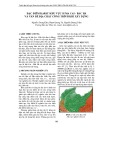
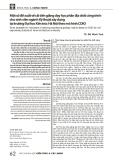
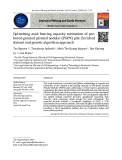
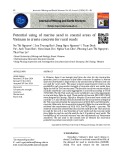
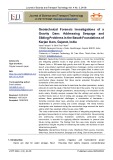










![Bài giảng Quản lý vận hành và bảo trì công trình xây dựng [chuẩn nhất]](https://cdn.tailieu.vn/images/document/thumbnail/2025/20251006/agonars97/135x160/30881759736164.jpg)







